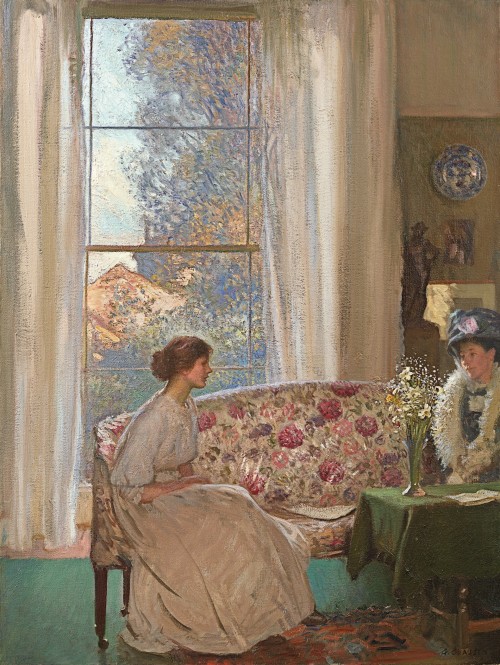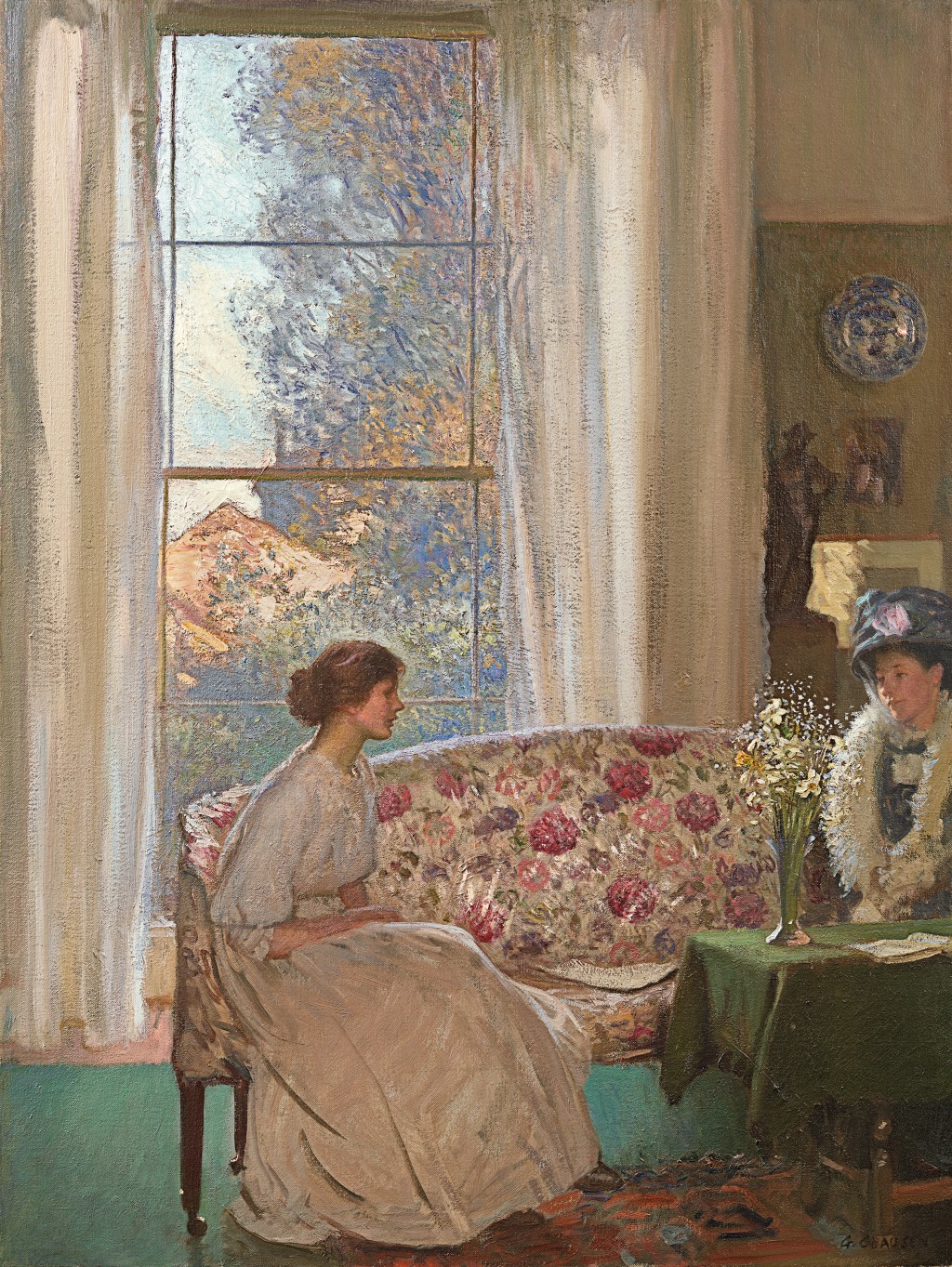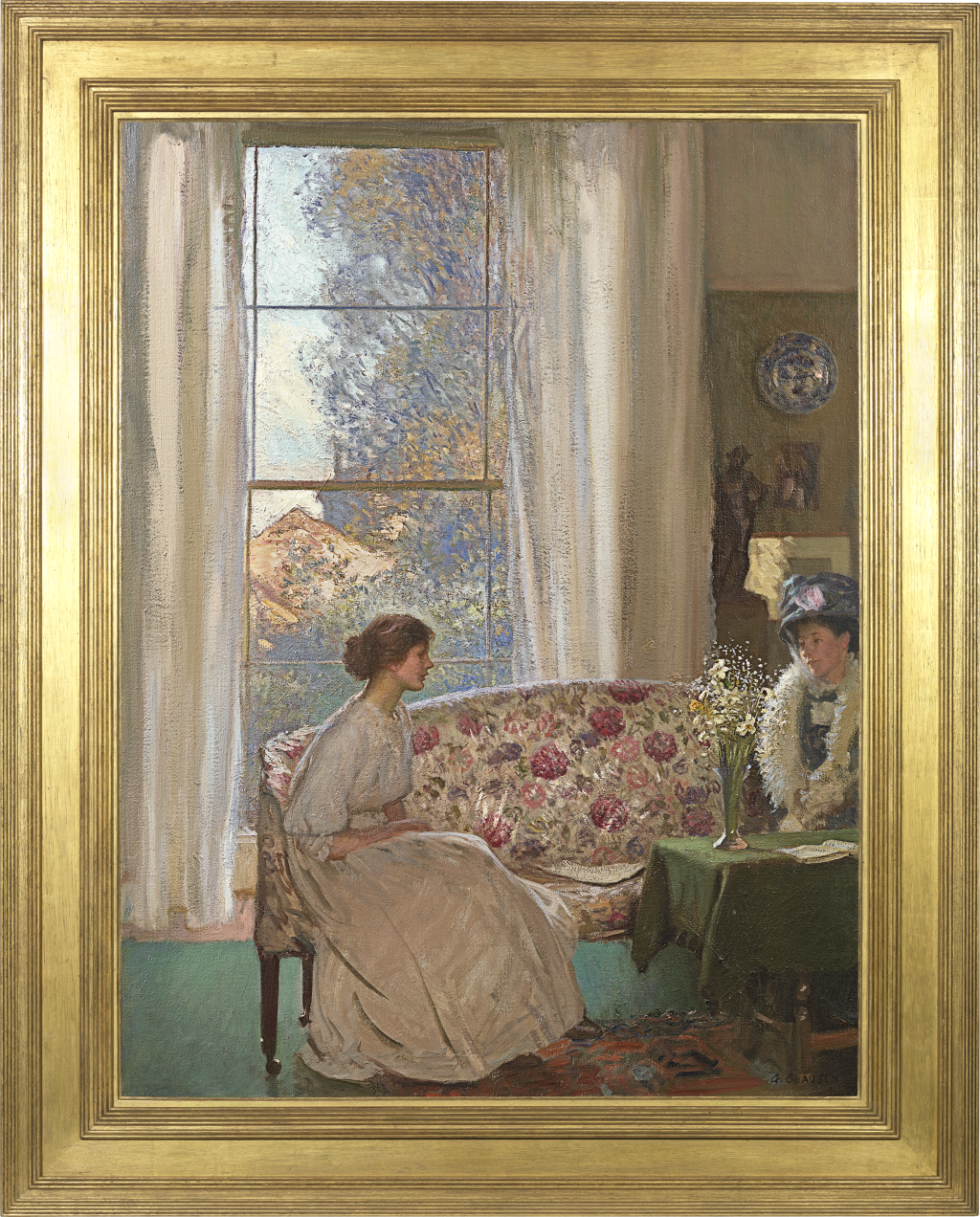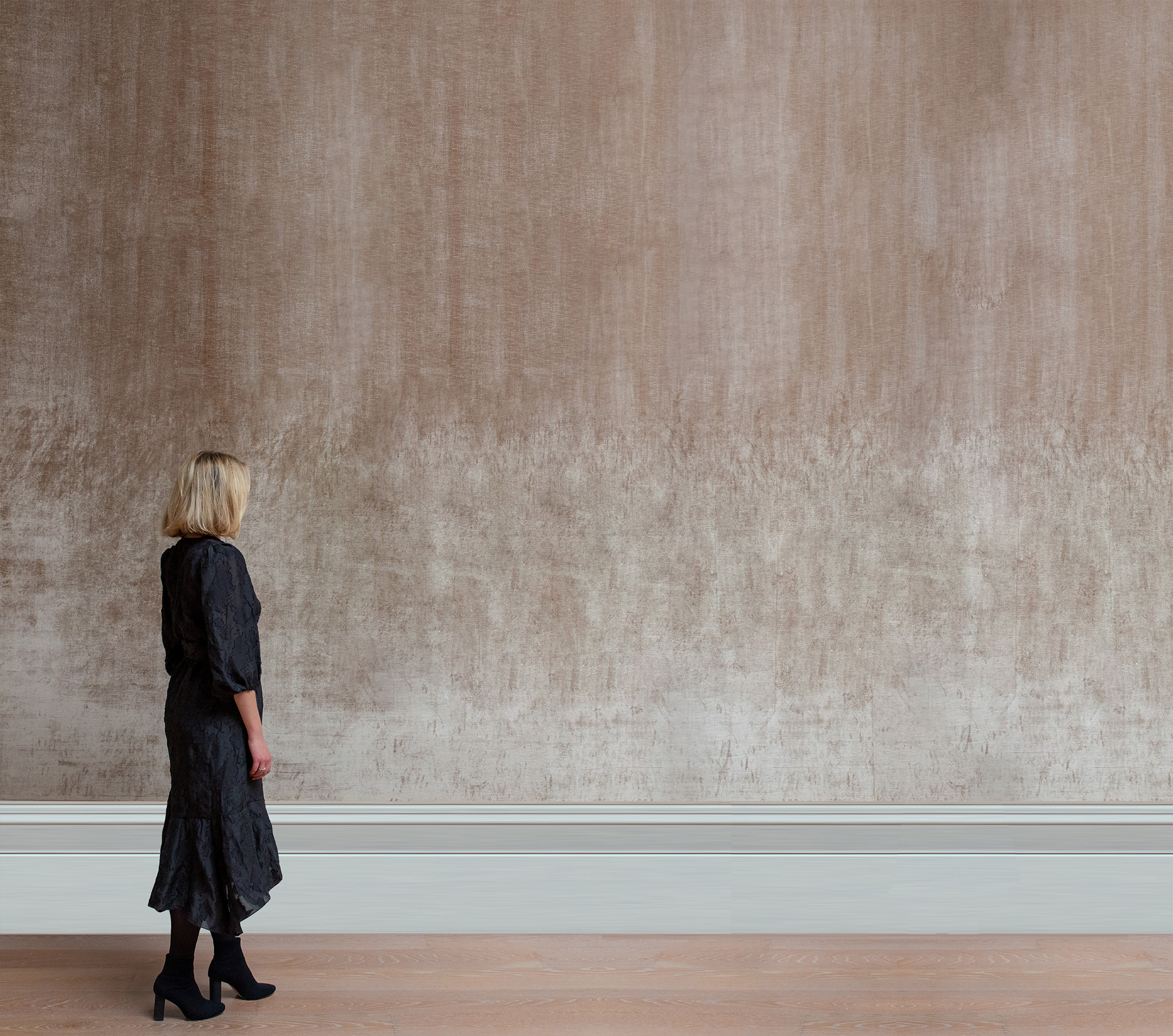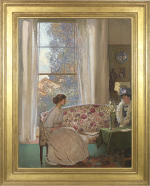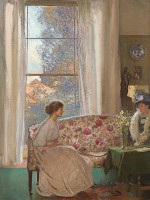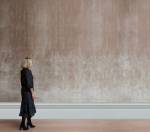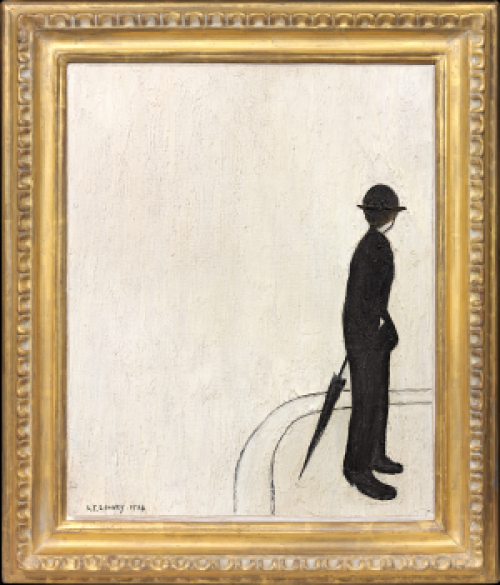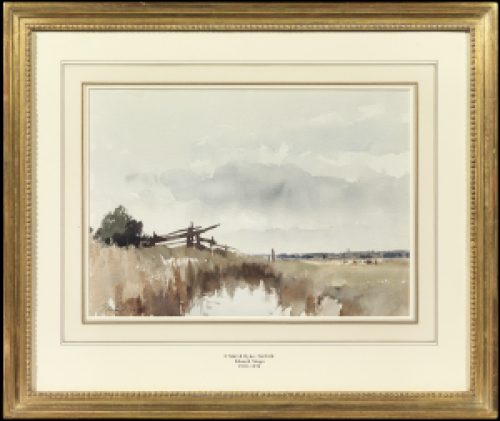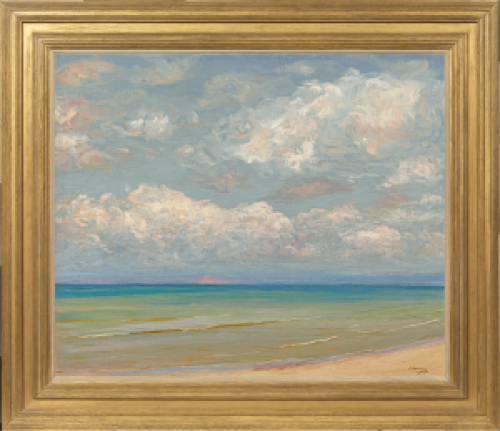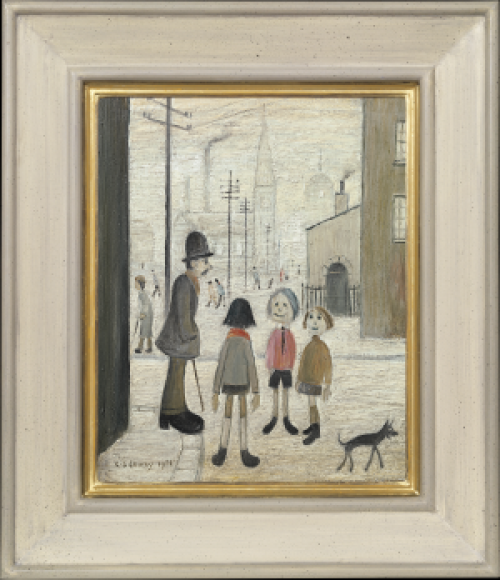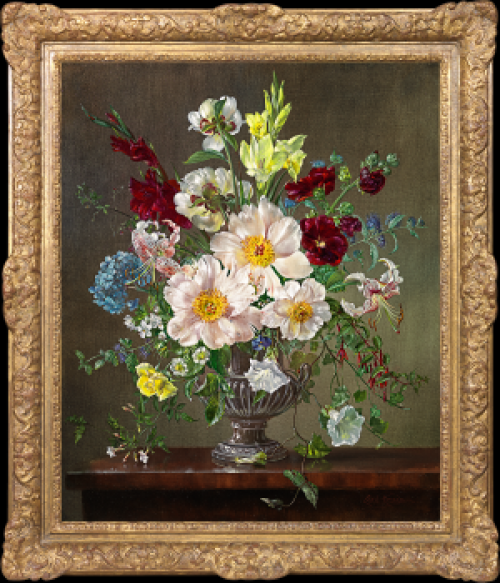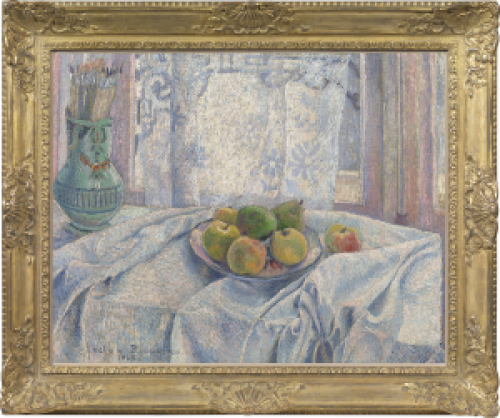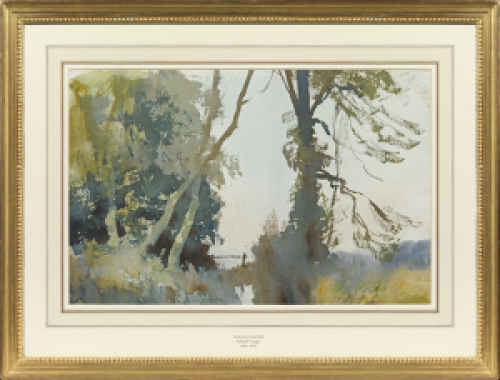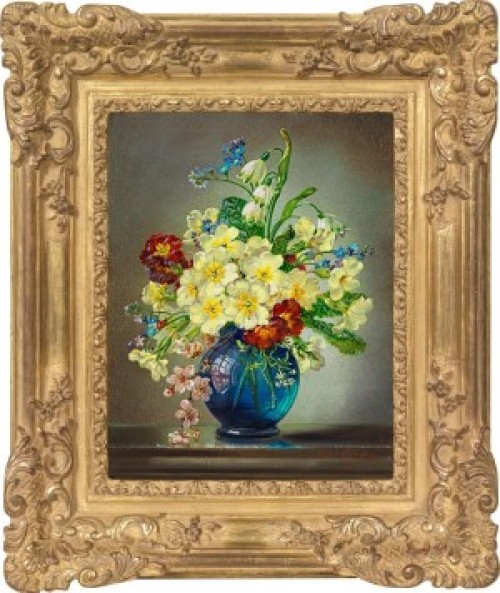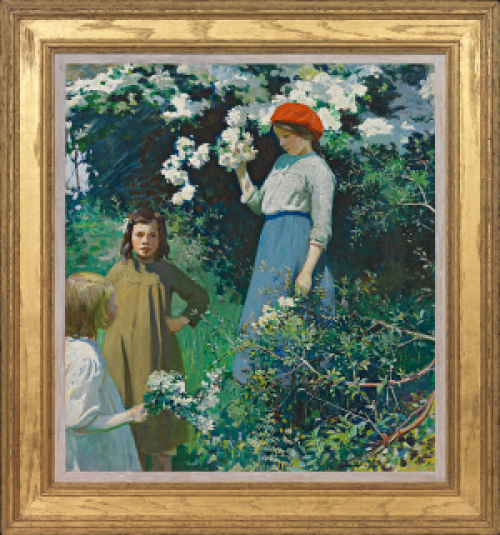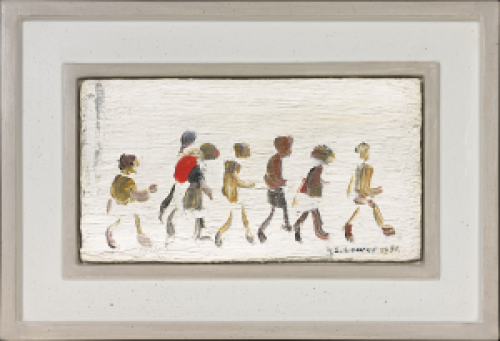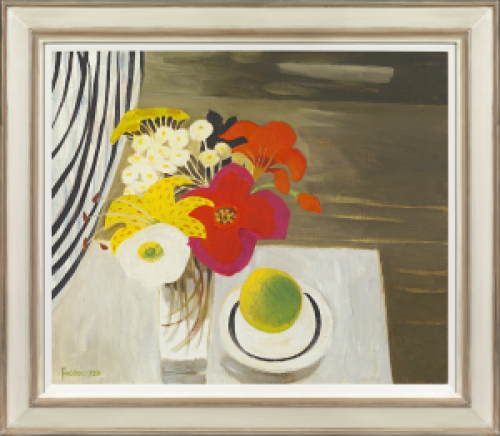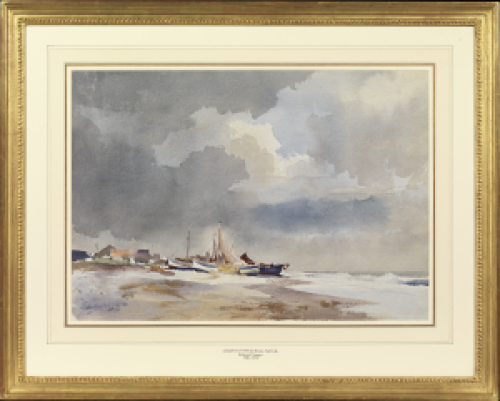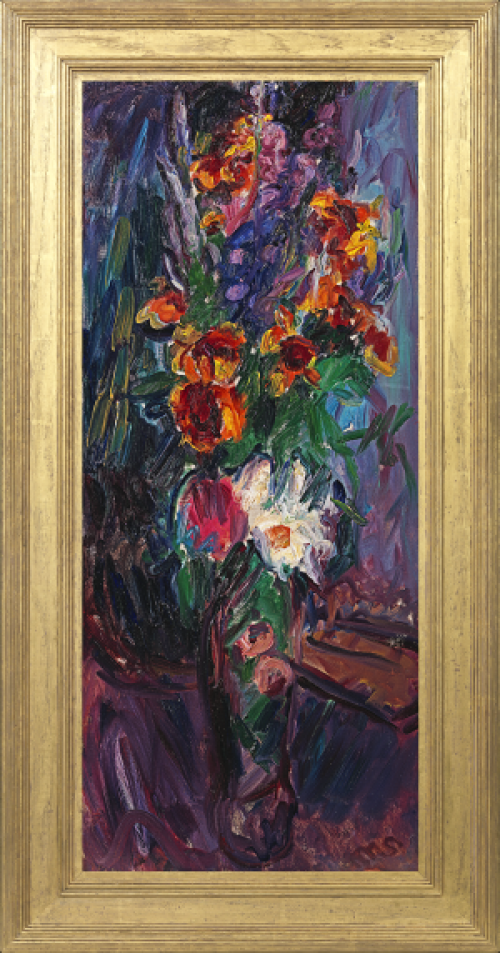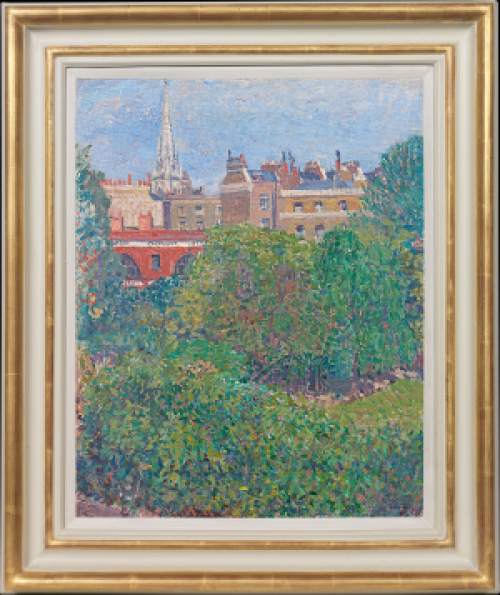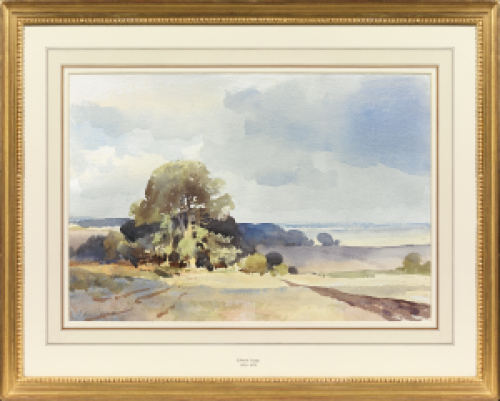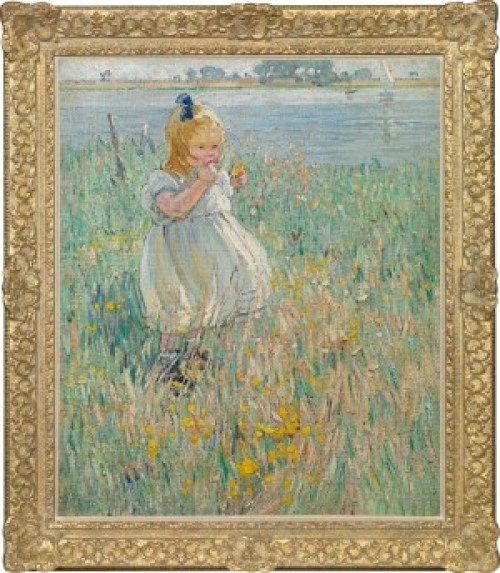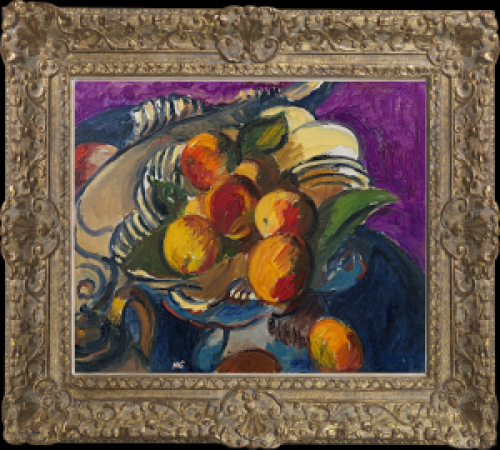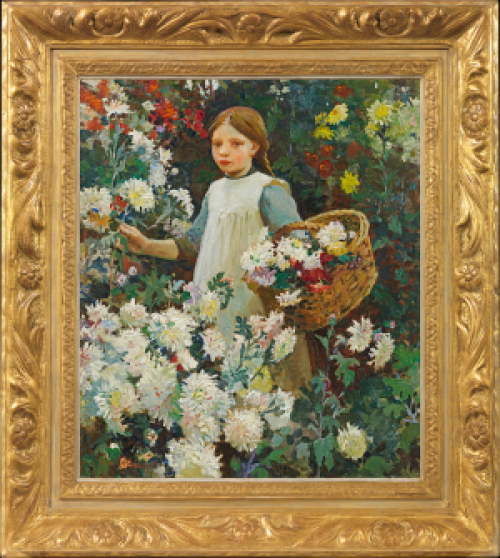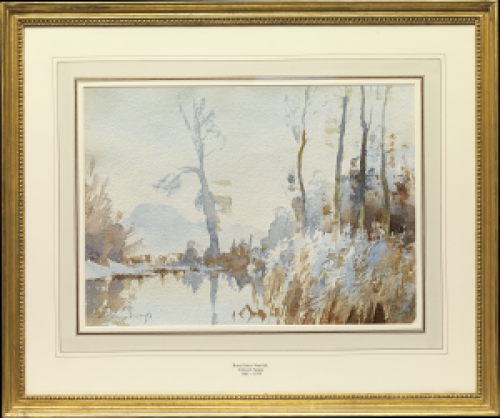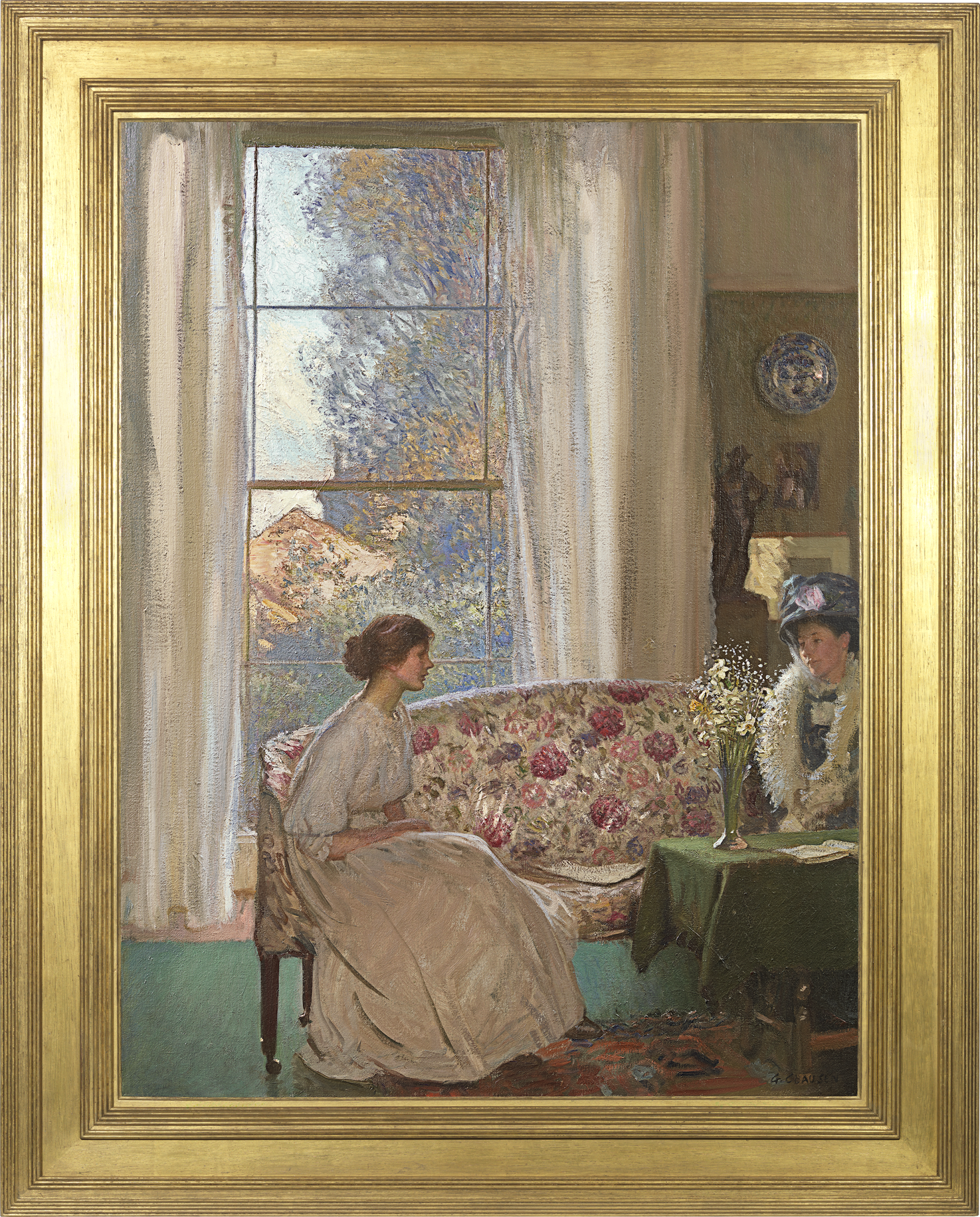SIR GEORGE CLAUSEN RA RWS
London 1852 - 1944 Cold Ash, Newbury
Ref: CA 206
The visit
Signed lower right: G. CLAUSEN
Oil on canvas: 40 x 30 in / 101.6 x 76.2 cm
Frame size: 49 ¼ x 39 ¼ in / 125.1 x 99.7 cm
Painted circa 1909
Provenance:
Private collection
Christie, Mason & Woods Ltd., London, 12th April 1946, lot 80, as By the window
M Newman Ltd, London, circa 1970;
Mrs Anneliese Derrick,[1] then by descent
Exhibited:
London, Leicester Galleries, Paintings and drawings by George Clausen RA, RWS, May-June 1909,
no.29
London, M Newman Ltd., Centenary exhibition 1870-1970, 7th May-5th June 1970, no.55,
as By the window, illus.
Cartwright Hall, Bradford City Art Gallery; London, Royal Academy of Arts; Bristol City Art Gallery; and Laing Art Gallery, Newcastle upon Tyne, Sir George Clausen RA, 1852-1944, 1980, no.107, illus.
Literature:
‘Art Exhibitions’, Western Daily Press, 24th May 1909, p.3
‘Leicester Galleries’, The Morning Post, 25th May 1909, p.5
‘Mr Clausen and Mr FE James’, The Times, 27th May 1909, p.9
‘The Leicester Galleries’, The Westminster Gazette, 11th June 1909, p.3
‘Mr Clausen at his Best’, The Manchester Courier, 29th May 1909, p.6
Anon, ‘Other Exhibitions’. The Athenaeum, No. 4257, 29th May 1909, p.653
‘For the Collector’, Illustrated London News, 23rd May 1970, p.29, illustrated full page,
as By the window
Peyton Skipwith, ‘Sir George Clausen’, The Connoisseur, vol 204, July 1980, illus. fig.9, p.184
Andrew Causey, Harold Gilman 1876-1919, exh. cat., Arts Council Touring Exhibition, 1981, p.8,
illus. fig.2, p.5
Kenneth McConkey, Edwardian Portraits: Images of an Age of Opulence, Antique Collectors’ Club,
Woodbridge, 1987, no.72, p.208, illus. p.209
Kenneth McConkey, George Clausen and the picture of English rural life, 2012, Atelier Books, Edinburgh, p.150, illus. fig.256, p.153
On a sunny day in a house in St John’s Wood, two women meet. One, in coat, boa and hat, is calling on the young woman who occupies the centre of the painting. Both are seated on a couch covered in floral chintz. On a small gate-leg table draped in green baize, stands a tall vase of delicate spring flowers. Behind the women, a large window gives onto the garden, while above the caller, light reflects in the glaze of a circular blue-and-white charger and the glass of a print that hangs beside a cast of The Mower by the contemporary sculptor, Hamo Thornycroft. Neither dingy and downtrodden, nor glitzy and nouveau riche, the setting for The visit signals calm aesthetic sophistication.[2] ‘Cool and fresh’ in the words of one reviewer, it was the ‘largest picture’ in George Clausen’s solo exhibition at the Leicester Galleries in London in May 1909 and his most important recent work.[3]
Five years before he unveiled The visit as the centrepiece of this exhibition, Clausen’s world had been transformed. Although he had been elected Associate of the Royal Academy in 1895, his appointment as its Professor of Painting in 1904 came as a shock to many who still regarded him as an outsider. Having lived and worked in the country for most of his career he had recently remained aloof from the seething art politics of Chelsea and Fitzrovia, and although he was not required to leave the landscapes and fieldworkers that inspired him, there were now compelling reasons to move to the metropolis.[4] The house at 61 Carlton Hill, St John’s Wood, having been owned by the Newlyn painter, Albert Chevalier Tayler, was conveniently located, both for the Academy and for the art schools his two daughters were attending. At the time of the move, his eldest daughter, Margaret Mary, known as Meg, and the principal figure in The visit, was studying design in the art department of Regent Street Polytechnic. With four other children in their late teens or twenties, easy access to city colleges had become essential.
Finding his feet in this new environment was more of a challenge. As he declared in one of his later Academy lectures, while ‘the city man…is quite as worthy [to be painted] as the average ploughman’, going to his office would seem ‘commonplace’, because, ‘the mind naturally refers to the beauty of the great elementary things – the sky, the sunshine, and the hills, rivers, fields and trees; and in people to those things that suggest beauty, activity, and health.’[5]
For a painter who appreciated such things, adjustment to his new surroundings was more difficult than it seemed at first, and while he continued to commute to Essex whenever possible, it was only when taking stock at his exhibition in 1909 that the full extent of the challenge he had faced, was apparent. While there were lots of subjects in the city, he confessed, when attempting to paint the shot towers at Lambeth, ‘getting there – through town, knocks everything out of my head’, whereas ‘in the country one could look at a tree day after day without disturbance and get to understand it.’[6]
Such reflections came three months after the opening of the exhibition in mid-May 1909. The show contained sixty small paintings and drawings, the exception being the present canvas. For those familiar with his paintings of field workers and ancient Essex barns, this London interior was a revelation. It announced a new and important area of subject matter, foretold two weeks earlier by a smaller painting, Twilight interior (fig 1), shown at the Royal Academy - The visit having been reserved as the centrepiece of the Leicester Galleries show, his third and most important solo exhibition, that was shortly to open.
Fig 1 Twilight: Interior (Reading by lamplight), 1909
Oil on canvas: 73.2 x 58.4 cm
Lotherton Hall, Leeds Museums and Galleries
In the minds of several reviewers, there was no question about the relative significance of the present for, ‘while most of these works’ on display, ‘do not pretend to be more than sketches or studies, there is at least one picture that ranks in importance with anything Mr Clausen is showing at the present moment at the Academy or elsewhere. This is the beautiful interior entitled “The Visit”. The foremost figure is that of a young girl, who sits on a chintz-covered couch, and whose head and shoulders are silhouetted against a large window, through which the bright sunlight forms a delicious contrast to the cool tones of the room. The picture is in the artist’s happiest vein, with its just tonality, its fine quality of colour and its evident artistic intention.’[7]
As always with major paintings, Clausen’s preparation was of the most rigorous kind. Careful drawings of the setting were squared up, furniture was arranged, and studies of Meg in profile, were made (figs 2 & 3).[8] As critics observed, the principal technical problem he faced was the tonal differentiation of interior and exterior space. While Meg’s face was observed contre jour, her features must not be lost. Elsewhere, forms that might otherwise be flattened in shade, must be given solidity by the careful notation of highlights. The observer’s eye must be completely persuaded, as the brightest of lights leak into the room and scatter themselves across the tips of flowers or the arm of the sofa.
Fig 2 Study for an interior, squared up Fig 3 Margaret Mary Clausen, c.1909
Ink and pencil: 28.1 x 39.6 cm Pencil: 20 x 15 cm [approx]
Royal Academy of Arts, London Private collection
The relationship between the present canvas and Twilight: Interior, purchased by the Leeds collector, Sam Wilson, was, nevertheless, obvious. And while the main elements of the present work are replicated in lamplight, with the addition of an armchair and a small gate-leg table, the full sunlight and figure of the visitor lift the present work into comparison with much admired Dutch masters. The Morning Post was more specific, declaring that ‘in “The Visit” he reveals objects in different degrees of light with as much conviction as Vermeer or Peter de Hooghe (sic).’[9] Henceforth Clausen would be known as an interior painter, but that having been said, he was not out for hire to the homes of the rich for ‘portrait interiors.’ There was only one interior, that of the sitting room that gave onto the garden at Carlton Hill, where the artist had his studio, and which we see here.[10]
Throughout these years, as a result of the success of his lectures, Clausen was embraced by the London art world, working with Henry Tonks on the art curriculum of the Girls’ Public Day School Trust and forming a friendship in the British Museum Print Room, where he researched some of his lectures, with the Assistant Keeper, the poet, Laurence Binyon,.[11] And while his role in the Academy brought committee and other responsibilities, the artist retained his watchful eye over the emerging painters in the New English Art Club, for whom, Binyon was an apologist.
There was nothing new in the problems posed by indoor and outdoor light represented in The visit. Walter Sickert applied a swift shorthand to many a figure posed in front of windows in down-at-heel bed-sit studios in Camden Town while Academy contemporaries like Stanhope Forbes orchestrated family gatherings in fishermens’ cottages. Led by William Rothenstein and William Orpen, numerous young painters in the New English were painting interiors that Binyon, in his column in The Saturday Review, attempted to describe. Speaking of Tonks, Orpen and others, he wrote: ‘Secluded from the unrestful emotions of our age…they remain serene. Collecting pieces of admirable furniture, choosing with judgement gaily harmonious patterns of chintz, their art dwells in charming interiors, where filtered sun caresses old silver and porcelain and bowls of flowers reflected in polished wood.’[12]
This shared experience of agreeable domesticity was also the ambiance of The visit. Nevertheless, such was the radicalism of the Academy’s Professor that one commentator on the 1909 exhibition remarked that it was, ‘Strange that he should have got himself associated with the Academicians instead of with the independents – [William] Nicholson, John Lavery, Charles Shannon, and [William] Orpen – with whom he has far more in common.’[13]
Where Sickert courted controversy in his ‘murder’ scenes and Orpen’s ‘Night’ series, with its large sash window, parallel to the picture plane, indulged an awkward melodramatic embrace, Clausen’s The visit and Twilight: Interior pulled back to a world where ‘normal things’ were ‘perfectly realized’ (fig 4).
Fig 4 William Orpen, Night no.2, 1907
Oil on canvas: 76.5 x 64 cm
National Gallery of Victoria, Melbourne
In Clausen, ‘the beauty of the thing seen’, as in Steen and Metsu, makes us feel ‘something more than that so many items are comprised in the picture.’[14] As in Vermeer, the eye caresses the objects, whether lifted into light or sunk into shade, for this was an intérieur intime, and not a theatre set. Its charm lasted beyond the works of 1909 in An interior, 1909-12 (fig 5), The window, 1912 (fig 6) and Winter morning interior, 1915 (Private collection).
Fig 5 An interior, 1909-12 Fig 6 The window, 1912 Fig 7 The quiet room, 1928
Oil on canvas: 76.2 x 63.5 cm Oil on canvas: 160 x 109.2 cm Oil on canvas: 71.5 x 61 cm
Private collection National Gallery of South Africa, Crawford Art Gallery, Cork
Cape Town
Even in the late 1920s, the painter would return to what had become an atmospheric and compositional archetype (fig 7).
At that point, the artist was staging his final retrospective exhibition. He had also stood in front of the paintings of Vermeer, the subject of a lecture he had given to students in Newcastle upon Tyne. If he had not fully realized it in 1909 this was ‘a perfect painter’, who, ‘in his ordinary surroundings, saw beauty so great that he was impelled to paint it.’ ‘Sympathy with nature and with humanity’ took Vermeer beyond ‘manner and attains to style.’[15] Clausen would also admit that words were inadequate. They could not begin to convey the feeling that the work of the master is a revelation – just as one critic had remarked of The visit, with equal inadequacy, that ‘the rendering of the woman’s face seen against the light [in The visit] is extraordinarily subtle and true.’[16] And what the painter had demonstrated in that year was a ‘power and versatility’ that was ‘amazing.’ He was, in short, ‘first and foremost a poet in paint.’[17]
Kenneth McConkey
[1] Mrs Anneliese Derrick (1924-2021), daughter-in-law of Thomas Derrick and Margaret Mary Clausen was therefore connected by marriage to the central figure in The visit.
[2] For a fuller discussion of the painting of interiors see Kenneth McConkey, ‘New English Intimisme – the painting of the Edwardian interior’, Anne Gray, The Edwardians – Secrets and Desires, exh cat, National Gallery of Australia, Melbourne, 2004, pp.89-105.
[3] ‘Art Exhibitions’, Western Daily Press, 24th May 1909, p.3
[4] McConkey, 2012, p.142. The move from Widdington in Essex to Carlton Hill was accomplished in the summer of 1905.
[5] George Clausen, RA, RWS, Royal Academy Lectures on Painting, Methuen & Co, 1913, pp.237-8.
[6] Letter to Havard Thomas, dated 21st August 1909, Hyman Kreitman Archive, Tate Britain; quoted in McConkey, 2012, p.156.
[7] ‘London Letter’, Manchester Courier, 29th May 1909, p.10.
[8] Since other views of the same interior followed The visit and Meg also posed in profile, facing right, for The student 1909 (Brighton Art Gallery, McConkey 2012, fig 254), the attachment of studies to specific works remains problematic, both for those in the Royal Academy collection, and others privately owned. Also problematic is the identity of Meg Clausen’s visitor, for whom no studies have yet been discovered.
[9] ‘Leicester Galleries’, The Morning Post, 25th May 1909, p.5.
[10] Clausen had of course painted barn interiors in the environs of Widdington and one or two cottage interiors such as A Normandy peasant, 1887 (Potteries Museum, Stoke on Trent), The breakfast table, 1890 (National Trust, Standen) and The bread 1893 (Private collection).
[11] In 1909 Clausen supplied a Preface to Binyon’s wife, Cicely Margaret Powell, for her book, The Mind of the Artist, Thoughts and Sayings of Painters and Sculptors, Chatto & Windus, 1909.
[12] Laurence Binyon, ‘Three Exhibitions’, The Saturday Review, 6th June 1908, p.720; quoted in Kenneth McConkey, 2004 as in note 1, p.98.
[13] ‘Pictures at the Leicester Galleries’, Leicester Daily Post, 21st May 1909, p.5.
[14] Lectures, 1913, p.165.
[15] George Clausen, ‘Vermeer of Delft and Modern Painting’, Charlton Lectures on Art, Oxford University Press, 1925, pp.66, 78.
[16] ‘The Leicester Galleries’, The Westminster Gazette, 11th June 1909, p.3.
[17] ‘Pictures at the Leicester Galleries’, Leicester Daily Post, 21st May 1909, p.5.

